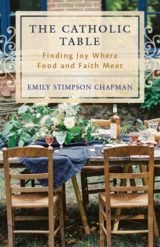By Emily Stimpson Chapman
Emily Stimpson Chapman is the award-winning author of several books, including The Catholic Table: Finding Joy Where Food and Faith Meet. She is also the host of the video study of the same name, The Catholic Table.

Years ago, while perusing a dusty old junk shop with a friend, I happened across a tarnished silver serving tray. It wasn’t solid silver—just silver plate—but it was beautiful. It was also five dollars. I bought it on the spot.
When I returned home I found some silver polish, cleaned up the platter, and used it to serve hors d’oeuvres at my next dinner party. I felt like the poshest hostess on the block. Considering that, at the time, I lived in a Washington, DC ghetto, that wasn’t much of a stretch.
After I moved to Steubenville and took up residence in another ghetto, I discovered that the antique stores in the area were full up with cheap silver plate, leftovers from the city’s more prosperous days. Thus my obsession began in earnest.
As a poor graduate student and fledgling writer, I wasn’t always flush with cash, but Steubenville silver was a luxury I could afford. Bit by bit, year by year, my little collection grew, until it reached the point where I owned enough silver to set a spread fit for royalty—dozens of platters and bowls; multiple coffee pots, tea pots, creamers and sugars; two sets of flatware, and all sorts of charming miniature plates perfect for cookies, nuts, and other treats.
At my wedding, we carted boxes of the stuff to the reception venue, using it to decorate mantles and tabletops. It looked lovely. Most of the time, though, my silver collection gets put to use for much humbler affairs: Easter brunches, Thanksgiving dinners, Christmas parties, and the countless little parties my friends and I throw to celebrate the Church’s liturgical feasts.
To some, whipping out a silver serving platter every Ascension Thursday might seem like overkill. But for me, those feasts aren’t just occasions to show off my flea market finds. They’re opportunities to help the people I love experience a small foretaste of the glorious feast God calls us to in eternity. Silver serving pieces, in their way, hint at the riches that await us there.
So too does the food they hold.
Depending on the day or the season, those silver platters are laden with bacon-wrapped dates, pepper-laced beef tenderloin, and honey-soaked ham. Peppermint meltaways, my grandmother’s cashew chocolate clusters, and lemon-cheesecake bars also know those platters well. Roasted vegetables of every sort, mashed potatoes whipped together with heavy cream, butter, and garlic, and salads bursting with dried fruits and nuts have all filled my silver bowls. Whether I’m serving five people or seventy-five, feast days at my house mean the table is set with a beautiful, shining abundance.
Which is just as it should be.
If you’re searching the Church calendar for the greatest feasts and greatest fasts, you’ll usually find them cozied up next to each other, with the fasts preparing us for the feasts to come, and the feasts helping us better understand the fasts just passed (see CCC 2043). In the balance, though, Christians who plan their meals according to the liturgical calendar will find themselves doing a great deal more feasting than fasting.
In the Catholic Church, every season of fasting is followed by a longer season of feasting. Lent is forty days. Easter is fifty. Advent lasts a little over four weeks. Christmas lasts a solid five and half weeks, beginning on December 25 and running right up to February 2, the Feast of the Presentation.
Moreover, while the Latin Church mandates two days of fasting (Ash Wednesday and Good Friday) plus another forty-eight or so days of abstinence (most other Fridays throughout the year), her calendar provides about three times as many opportunities for feasting.
We feast on Christmas Day and Easter Day, Holy Days of Obligation, Solemnities, and every single Sunday, all of which the Church considers “little Easters.” We also can choose to celebrate favorite saints and martyrs on the dozens and dozens of days set aside to remember them. Heck, we can even feast in honor of buildings. The papal basilica of St. John Lateran and the Portiuncula chapel rebuilt by St. Francis both have feasts of their own (November 9 and August 2, respectively).
In the Catholic Church, we always have cause for feasting. Which is grand for someone who likes hosting parties as much as I do. But the ultimate cause for our feasting is never a saint or a stunning work of architecture. The ultimate cause is always Christ.
You Might Also Like

Every one of us has to eat. Some of us eat too much food. Or we eat too little. Sometimes we eat without gratitude, without charity, or without respect. But, as award-winning author Emily Stimpson Chapman explains in The Catholic Table, with a sacramental worldview, the supernatural gift of God’s grace can transform and heal us through the food we make, eat, and share.